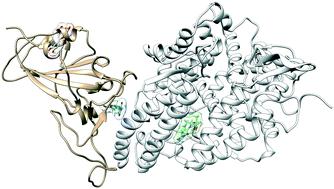当前位置:
X-MOL 学术
›
Mol. Syst. Des. Eng.
›
论文详情
Our official English website, www.x-mol.net, welcomes your
feedback! (Note: you will need to create a separate account there.)
Molecular characterization of COVID-19 therapeutics: luteolin as an allosteric modulator of the spike protein of SARS-CoV-2
Molecular Systems Design & Engineering ( IF 3.2 ) Pub Date : 2021-09-15 , DOI: 10.1039/d1me00119a Walter Alvarado 1 , Gustavo R. Perez-Lemus 2 , Cintia A. Menéndez 2 , Fabian Byléhn 2 , Juan J. de Pablo 2
Molecular Systems Design & Engineering ( IF 3.2 ) Pub Date : 2021-09-15 , DOI: 10.1039/d1me00119a Walter Alvarado 1 , Gustavo R. Perez-Lemus 2 , Cintia A. Menéndez 2 , Fabian Byléhn 2 , Juan J. de Pablo 2
Affiliation

|
The interactions between the receptor binding domain (RBD) of SARS-CoV-2 and the angiotensin-converting enzyme 2 (ACE2) are crucial for viral entry and subsequent replication. Given the large and featureless contact surfaces between both proteins, finding a suitable small-molecule drug that can bind and disrupt regulatory pathways has remained a challenge. A promising therapeutic alternative has been the use of small compounds that bind at the protein–protein interface or at distal “hotspots” and induce conformational changes that inhibit or stabilize protein–protein interactions (PPIs). In this work, we conduct large-scale all-atom explicit solvent simulations of the top scoring compounds from a recent large-scale high-throughput docking screening to investigate their interaction with the RBD domain of the spike (S) protein in complex with ACE2. We identify several promising candidates that exhibit a large negative free energy of binding to the RBD/ACE2 complex based on ab initio thermodynamic integration calculations. A systematic structural analysis of two glycosylation profiles of the RBD/ACE2 complex reveals the important role glycans play in modulating the binding of small-molecules. Cross correlation, fluctuation and strain analysis identify several of these compounds as effective PPI modulators that inhibit or stabilize the protein–protein interactions of RBD/ACE2 based on the glycosylation profile. Among them, luteolin, a drug currently approved for asthma, exhibits an intense allosteric effect when it binds to a previously unidentified distal binding site of the RBD domain far from the RBD and ACE2 interface which may serve as a potential target for future drug discovery.
中文翻译:

COVID-19 疗法的分子特征:木犀草素作为 SARS-CoV-2 刺突蛋白的变构调节剂
SARS-CoV-2 的受体结合域 (RBD) 与血管紧张素转换酶 2 (ACE2) 之间的相互作用对于病毒进入和随后的复制至关重要。鉴于两种蛋白质之间的接触面大且无特征,找到一种可以结合和破坏调节途径的合适小分子药物仍然是一个挑战。一种有前景的治疗替代方案是使用小化合物,这些化合物结合在蛋白质 - 蛋白质界面或远端“热点”处,并诱导抑制或稳定蛋白质 - 蛋白质相互作用(PPI)的构象变化。在这项工作中,我们对最近大规模高通量对接筛选中得分最高的化合物进行大规模全原子显式溶剂模拟,以研究它们与与 ACE2 复合的刺突 (S) 蛋白的 RBD 结构域的相互作用.从头算热力学积分计算。对 RBD/ACE2 复合物的两种糖基化谱的系统结构分析揭示了聚糖在调节小分子结合中的重要作用。交叉相关、波动和应变分析将这些化合物中的一些鉴定为有效的 PPI 调节剂,可基于糖基化特征抑制或稳定 RBD/ACE2 的蛋白质-蛋白质相互作用。其中,木犀草素是一种目前被批准用于治疗哮喘的药物,当它结合到远离 RBD 和 ACE2 界面的 RBD 结构域的一个以前未知的远端结合位点时,表现出强烈的变构效应,这可能是未来药物发现的潜在目标。
更新日期:2021-11-24
中文翻译:

COVID-19 疗法的分子特征:木犀草素作为 SARS-CoV-2 刺突蛋白的变构调节剂
SARS-CoV-2 的受体结合域 (RBD) 与血管紧张素转换酶 2 (ACE2) 之间的相互作用对于病毒进入和随后的复制至关重要。鉴于两种蛋白质之间的接触面大且无特征,找到一种可以结合和破坏调节途径的合适小分子药物仍然是一个挑战。一种有前景的治疗替代方案是使用小化合物,这些化合物结合在蛋白质 - 蛋白质界面或远端“热点”处,并诱导抑制或稳定蛋白质 - 蛋白质相互作用(PPI)的构象变化。在这项工作中,我们对最近大规模高通量对接筛选中得分最高的化合物进行大规模全原子显式溶剂模拟,以研究它们与与 ACE2 复合的刺突 (S) 蛋白的 RBD 结构域的相互作用.从头算热力学积分计算。对 RBD/ACE2 复合物的两种糖基化谱的系统结构分析揭示了聚糖在调节小分子结合中的重要作用。交叉相关、波动和应变分析将这些化合物中的一些鉴定为有效的 PPI 调节剂,可基于糖基化特征抑制或稳定 RBD/ACE2 的蛋白质-蛋白质相互作用。其中,木犀草素是一种目前被批准用于治疗哮喘的药物,当它结合到远离 RBD 和 ACE2 界面的 RBD 结构域的一个以前未知的远端结合位点时,表现出强烈的变构效应,这可能是未来药物发现的潜在目标。











































 京公网安备 11010802027423号
京公网安备 11010802027423号